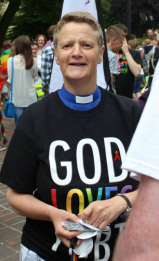Later in the week, my guide showed me around the different places that his family had been forced to live, as the authorities changed the designation of different areas. He was classed as “Cape Coloured”, not treated as badly as Black South Africans, but certainly not white. The startling example of this housing policy was an area of District Six, near where Good Hope MCC used to worship. This area of land was completely cleared of housing one day by bulldozers and the people forcibly evicted. The land still lay empty when I was there, except for a church building, which even the bulldozer drivers dared not destroy. One day, we saw schoolboys climbing over a fence, clearly taking time out from school. My guide was furious and told me about all the protests that he had been on, just to have access to a basic education.
I met older Black South Africans who told me what it was like to vote for the first time ever and younger ones who told me that they didn’t feel affected by apartheid at all. I met White South Africans who were frightened and felt deeply threatened by the changes that they were seeing in their country, and as well as others who were part of movement to bring down apartheid.
From the comfort of the UK, it is impossible to imagine what it must have been like to live under apartheid, for anyone in South Africa. How then, must it have been to see Nelson Mandela released from prison and to have the opportunity to elect him as President? Instead of a blood bath and retribution, there was the promise of a rainbow nation and opportunities for all. One man’s determination to show grace, forgiveness and faith in humanity made the difference between a country plunged into civil war and a nation working towards reconciliation and peace. The world is a better place for the life and example of Nelson Mandela.
God bless,
Cecilia

 RSS Feed
RSS Feed